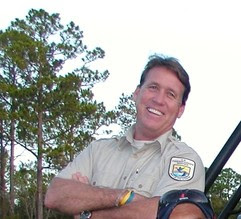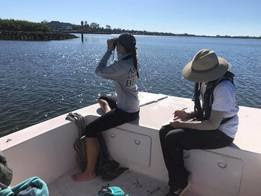FSA Partnership Meetings:
March 4: St. John's/Flagler Partnership, 1-4pm, St. Augustine Alligator Farm, email Jean Olbert
March 8: Space Coast Partnership, 10am-1pm, Kiwanis Island Park, email Anna Deyle
March 28: Lee County Partnership, 12-3pm, Florida Gulf Coast University, email Morgan Parks
Florida Shorebird Database (FSD) Training:
March 11, 1-2pm(EST): FSD webinar for new surveyors
March 12, 1-2pm(EST): FSD webinar for returning surveyors
March 13, 1-2pm(EST): FSD webinar for rooftop monitors
Beach Stewardship Training:
March 7, 1pm: Longboat Key Beach-nesting Bird Program, Bayfront Park Recreation Center, email Kylie Wilson
March 16, 9am: Ft. Desoto Stewardship Training, meet at Ft. Desoto North Beach Snack Bar, email Holley Short
March 23, 9am: Siesta Key Stewardship Training, Sea Turtle Pavilion on Siesta Key public beach, email Kylie Wilson
Events:

Partner Spotlight: Vic Doig of the Nature Coast Shorebird Partnership
For 15 years, Vic Doig has been with the Lower Suwannee and Cedar Keys National Wildlife Refuge. Despite his official title of Fire Management Officer, he also wears many other conservation hats. His previous role as an FWC Wildlife Management Area biologist has also allowed him to fill the role of refuge wildlife biologist. When he is not managing prescribed burns on the refuge, traveling around Florida and the rest of the country to support other fire programs, or monitoring gopher tortoises, bald eagles, and wading birds, Vic somehow finds the time to also monitor shorebirds.
Vic has been involved in the Nature Coast Shorebird Partnership since its beginnings in 2009. While the expansive pristine marsh habitat of the Nature Coast provides excellent foraging habitat, there is a limited amount of shorebird nesting habitat. Yet least terns, American oystercatchers, Wilson’s plovers and willets are still able to find hidden pockets to nest. Vic leads the effort to survey the extensive 30-mile coastline that the refuge encompasses during the breeding season!
Additionally, Vic Doig and Deputy Manager Larry Woodward (another FWS employee who wears many hats), undertook a project to create nesting habitat for seabirds, in particular least terns. Nesting seabirds and shorebirds in the Cedar Key area experience regular overwash events, resulting in poor nest success. To combat this, Vic, Larry, and other refuge staff designed a raised nesting platform built on an abandoned dock structure at Atsena Otie Key in the Cedar Keys NWR. Outfitted with nesting substrate, an acoustic playback system, and decoys, this will be the third year the platform is in place. No nesting has occurred yet, but many target species have used the platform as a loafing area.
Even though Vic’s schedule is jam-packed, his dedication to wildlife, positive attitude and amiable nature stand out, making him a pleasure to work with in the Nature Coast. We are fortunate to have him as a partner. Thank you, Vic!
|

The 2019 Shorebird Breeding Season is Here!
This newsletter is all about helping you prepare for shorebird conservation and monitoring during the 2019 breeding season. Your local partnership is organizing many activities, so please coordinate with them. The best way to do that is to attend a partnership meeting. If you can’t attend the meeting but would like to get involved, please contact shorebird@myfwc.com. Here are a few ways to get started:
Be a mentor, or team up with one. Does your partnership have new members? If so, encourage them to join a local bird steward program or bring them along on a monitoring survey. If you're a new member, check with your partnership for training and mentoring opportunities.
Get outreach materials. There are posters, brochures, coloring books, rooftop signs for businesses, etc. (see selection). Your FWC regional office may have them in stock.
Prepare for route surveys. If you have an assigned route, will you be able to survey it during all 6 count windows? If not, please find someone to fill in for you (or contact us for help). Remember to coordinate survey plans with your local partnership and register for a route or rooftop training webinar.
Prepare for roof monitoring. Can you help monitor rooftops with nesting birds? If so, coordinate with your partnership or contact us. Please let us know if roofs are no longer suitable for nesting (building was torn down or re-roofed).
Read on for more details about getting involved this season...

Posting Nest Sites
“Posting” means to install a symbolic fence of signs and twine or rope around a nest or colony. Posting is often the best tool to protect beach-nesting birds from human disturbance on popular beaches and islands. “Pre-posting” a section of the beach to give the birds an undisturbed place to initiate nesting is also a great tool, especially if you want to attract birds to a protected spot before they establish nests.
If you find a shorebird nest or seabird colony that has not yet been posted, please notify the local land manager or your FWC regional shorebird contact immediately so that it can be posted. Parks usually have their own preferred signs and posting materials, but if not (or if the nest is on private property), supplies and assistance can be requested by contacting your FWC regional shorebird biologist. Check out our sign selection – many can be printed off and laminated (remember to obtain landowner’s permission to post on private property).
Detailed posting instructions are available on the FSA website. |

Bird Stewarding and Outreach
One of the greatest threats beach-nesting shorebirds face is disturbance from people, pets, and vehicles in the nesting area. Under these circumstances, signs posted around the nests are not enough to prevent people from disturbing nesting birds, and it requires time and effort from caring individuals, or beach stewards, to monitor the nests and chicks.
Shorebird steward programs are organized by shorebird partnerships throughout Florida. Where and when bird stewards will be needed is not fully determined until the birds have started nesting. This usually starts in March and can run into September, depending on the bird species. Stewarding begins after the nests and colonies are located and posted by biologists. Although the greatest needs for stewards is on weekends and holidays, stewarding can be done anytime an area has active shorebird nesting. While out on the beaches, stewards carry out two important tasks: 1) minimizing disturbance to the nests, and 2) informing the public about beach nesting birds.
To volunteer as a bird steward this season, please check this map to see if there is a steward program near you. If so, please call or email the program contact to get involved. If there is not a bird steward program near you, contact us about starting one. In addition to stewards, land managers and private citizens can also do a lot to educate others about beach-nesting birds. We have outreach materials to help you get the message out to beach drivers, photographers, and pedestrians on the beach.
Bird Stewards photo by Bonnie Samuelsen
|

Breeding Bird Surveys and Training
Florida’s official shorebird monitoring program begins this month, with the first count window from March 18th – 24th. Everything you need to know to participate in the monitoring program can be found on the Florida Shorebird Database (FSD) website.
The website’s INSTRUCTIONS tab details what the monitoring program involves. The RESOURCES page contains videos on data entry and the Breeding Bird Protocol (BBP), which explains the monitoring process and includes data sheets.
All volunteers are encouraged to register for a training webinar. The March 11th webinar is for new volunteers who plan to survey a specific route (usually along the beach). The March 12th webinar is for returning volunteers and includes important updates to the BBP and FSD interface. The March 13th webinar is for volunteers who plan to monitor rooftops and includes important updates to the rooftop section of the BBP and FSD interface .
All webinars are from 1-2pm Eastern.
Details and instructions will be emailed to registered participants prior to the webinars.
Photo by Holley Short
|

Rooftop Monitoring and Outreach
Many seabirds and shorebirds nest on gravel rooftops in Florida, making rooftop monitoring and outreach important components of our work. There are hundreds of rooftops throughout the state where seabirds have historically nested, and we need your help monitoring them. If you are willing to check on a nearby rooftop, please contact your local partnership to learn where you can assist. If you would like to become a monthly rooftop monitor, March - August, please review the rooftop section of the Breeding Bird Protocol.
If you see shorebirds or seabirds flying to or from a rooftop, the birds are likely nesting on that roof. It is important to talk to the property owners or managers, to help make them aware of the protected species nesting on their roof. The building’s residents or employees can alert you if there are falling chicks or other issues, so it’s important to talk to them early in the season and leave a phone number they can call. We have signs, letters, postcards, and other Rooftop Resources to help you with outreach.
At rooftops where birds nest every year, there may be things you can do to prepare for the upcoming season. First, please remind the property owner to schedule rooftop repairs or air conditioning maintenance the month before the birds arrive. Also, some partnerships are “chick-proofing” rooftops, so please contact your local partnership to see if they need help.
If you see chicks falling off the roof, they should be returned to the rooftop as soon as possible. Please consult the Chick-Checking Manual for further instructions.
"Chick-proofing" photo by Bonnie Samuelsen
|

Spring Cleaning Checklist
The Florida Shorebird Database is now open! Before entering your breeding data this season, you may want to do a little spring cleaning of your Florida Shorebird Database(FSD) account:
Remember, the Florida Shorebird Database website is most compatible with Google Chrome web browser. You can work faster and more efficiently using Chrome instead of other browsers.
Create a Florida Shorebird Database account if you don't have one yet and plan to monitor shorebirds and seabirds this season. (click on New User? Get registered).
If you already have an account, make sure that you can still log in. If your password doesn’t work, you can reset it by emailing FLShorebirdDatabase@myfwc.com. Please do not create a new account.
Check your Account Info (top right of screen). Is your contact information up to date? Do you have the correct Partnership selected? Select the partnership nearest you (preferred) or you can select “Multiple” if you belong to more than one partnership. Please update this section then click Submit.
Review the routes and/or rooftops on your MY DATA page (imported into your profile from last year). Are you still planning to survey those routes or rooftops this year? If not, you may want to remove them from your profile to speed up page loading (go to View/Edit and then select “Remove from My Data”). This won’t erase them from the system, but they will no longer appear in your profile.
Double check the location of the routes you are planning to survey (be sure to zoom in!). Does the location of the route line match where you actually survey? If not, you should create a new route and email FLShorebirdDatabase@myFWC.com to retire the obsolete route.
For the rooftops you are planning to survey, review the rooftop management details and make any edits necessary. If a rooftop is no longer suitable for nesting, please notify FLShorebirdDatabase@myfwc.com and we will retire the rooftop.
Thank you for your dedication to shorebird and seabird conservation. May the 2019 nesting season be highly productive!
|

No comments:
Post a Comment